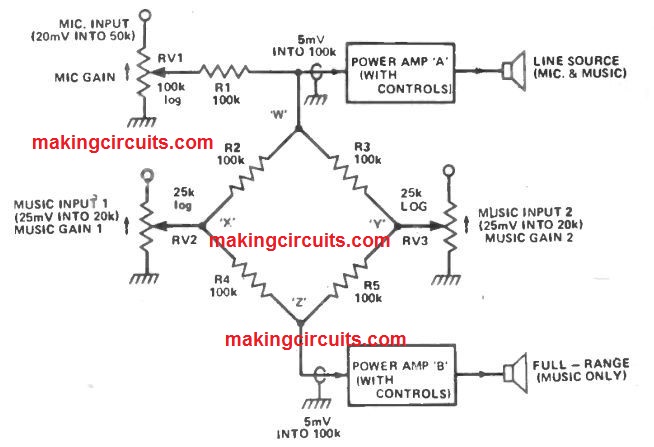This anti acoustic feedback circuit can be used to prevent the howling effect that is normally seen when an amplifier and a loudspeaker system are operated inside a hall within a close proximity
The directional qualities of Line Source Loudspeakers are ideal for reducing acoustic feedback ("Howl - Round"); sadly their bass effect is generally insufficient to the entire musical range.
The best system might comprise of an entirely isolated amplifier system for microphone inputs terminating in line source loudspeakers, the "music" being amplified separately and provided at appropriate power levels to less directional full range loudspeakers.
On the other hand, since this is expensive and raises transport issues, a system has been progressed where a complete range non directional loudspeaker might react to "music" inputs only, a line source being employed simultaneously answering to equally "music" and "mic." inputs.
The principle have been shown in process utilizing the passive network demonstrated in the diagram. Since the input of the microphone is suppressed consecutively by three potential dividers just before reaching the full range loudspeaker system, the chance of feedback using this speaker is minimal.

Generally there exists a minimum of 26 dB decrease in microphone signal voltage amongst the input to amplifier 'A' and also the input to amplifier 'B'.
The anti acoustic feedback circuit is effortlessly designed some other signal levels and impedance by adjusting part values on a equivalent basis; a more detailed "active" system is achievable utilizing virtual earth summing amplifier stages.
Simulated stereo can be done through monophonic programme material by linking a capacitor (around 2n2) across point 'Z' and ground; an additional capacitor (around 'I nO) being attached in series at 'W'.
An built in benefit of the system is that a "music" output is acquired even though among the power amplifiers, or amongst the loudspeakers, might go defective while the operation.
Leave a Reply